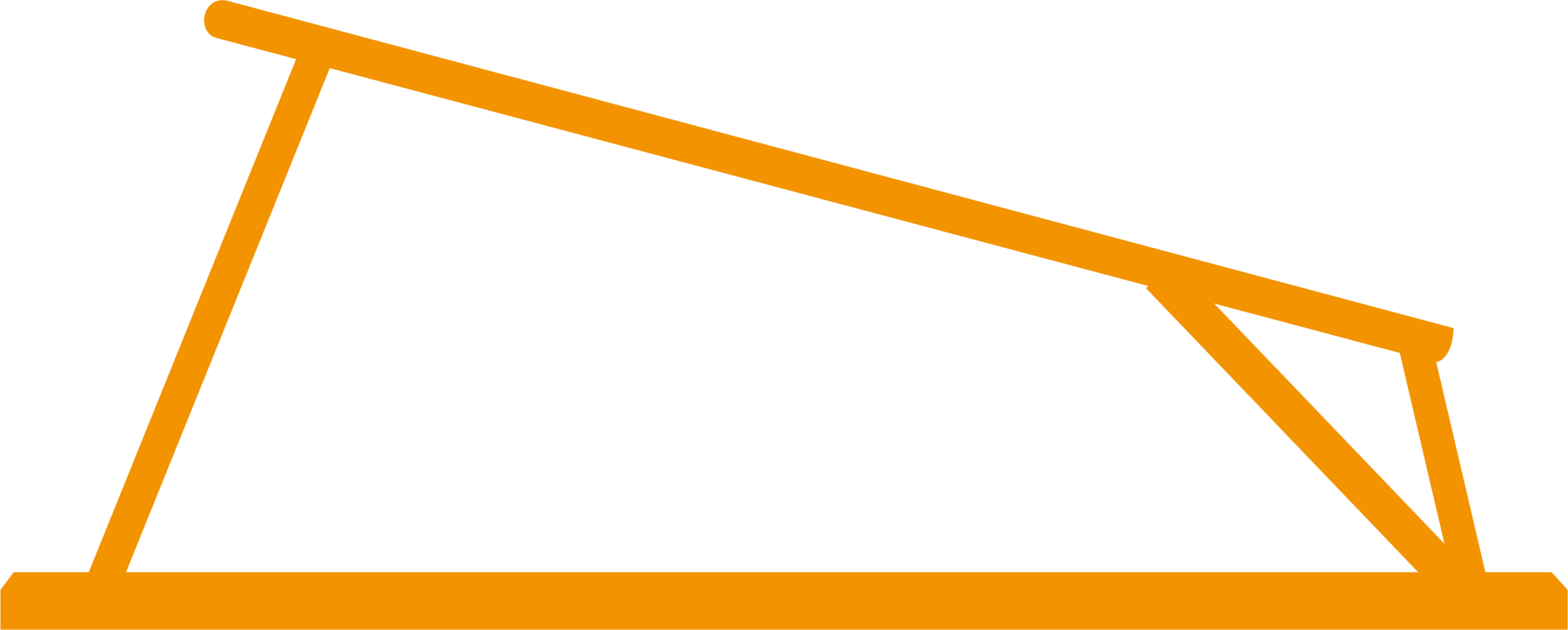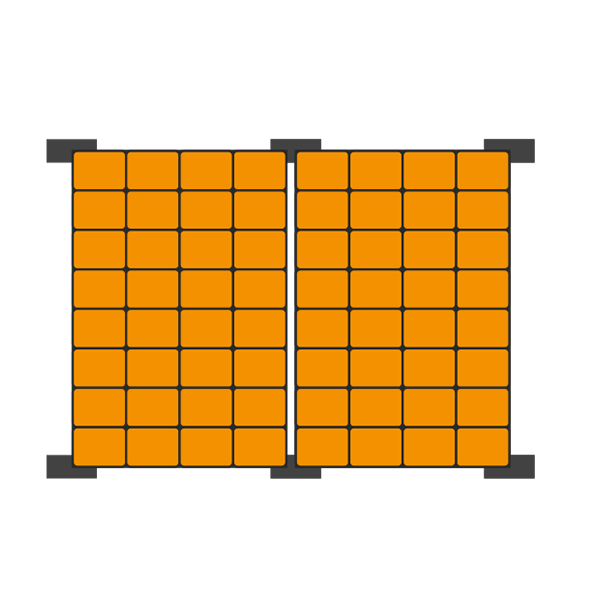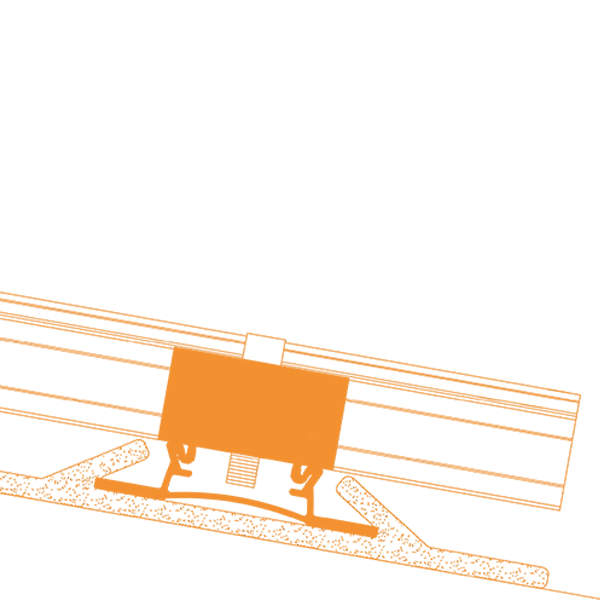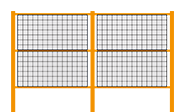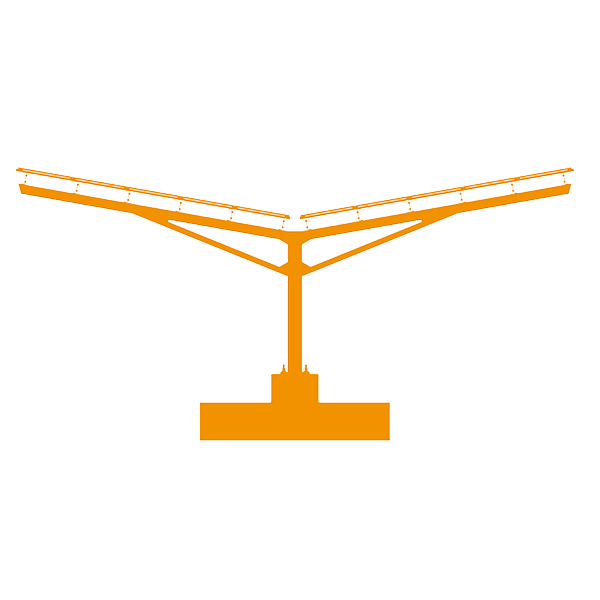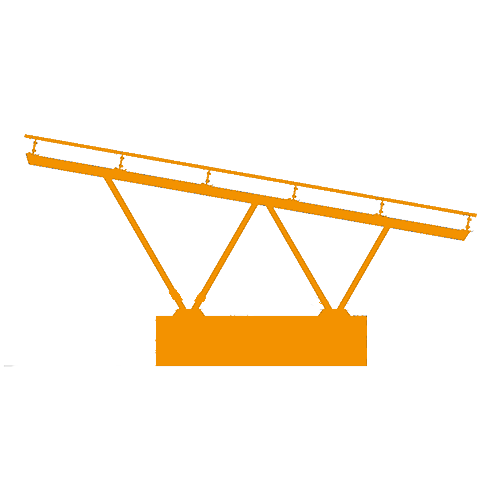Agri-PV – Landnutzung und Solarenergie
Agri-PV System
Pan & Artemis
Discover the future of agriculture with Agri-PV!
The innovative integration of photovoltaic systems combines agricultural
land with electricity production.
In accordance with DIN SPEC 91434 and 91492, a distinction is made between high-mounted and ground-mounted systems.
By installing solar modules on agricultural land, land use can be optimized while at the same time preserving valuable arable and pasture land.
Rainwater can be drained away via the system, minimizing erosion and undermining of the soil.
Using specific irrigation concepts, this water can be supplied to the crop in a targeted manner.
The stabilization of crop yields through protection against storm, hail, frost and drought damage is another positive effect to which a high-mounted Agri-PV system contributes.
Cost reduction for farms by generating renewable solar power for their own consumption
High level of acceptance among the population and politicians, especially in comparison to traditional ground-mounted systems
Module orientation in east-west or south possible combined with simple installation thanks to mobile design
Promotion of biodiversity through flower strips with simultaneous energy production
Sie haben Interesse an individuellen Agri-PV Lösungen und suchen einen professionellen Partner für Ihre Projekte? Kontaktieren Sie uns!
Planning | Design | Consulting
Gerne unterstützen wir Sie bei Ihrer Projektplanung mit unserer Kompetenz in folgenden Bereichen:
- Beratung
- Begehung vor Ort
- Montagevarianten
- Erstellen von Plänen & Zeichnungen
- Modulbelegung
- Verschattungsberechnung
- Stringplanung
Statics | Soil expertise
Speziell für Agri-PV & konventionelle Freiflächen-Projekte bieten wir die Erstellung von Statik- sowie Bodengutachten an.
- Statikgutachten
- Windsogberechnung
- Schneelastgutachten
- Abnahmegutachten
- Schadensgutachten
Assembly & erection
Wir bringen Sie mit starken Partnern der Photovoltaik zusammen. Unsere Experten kennen sich bestens mit unserer Unterkonstruktion für Agri-PV aus. Dabei unterstützen wir Sie mit:
- Rammarbeiten
- Gestellmontage
- Modulmontage
- Bereitstellung Manitou, Radlader, Bobcat
- Baustelleneinrichtung
- DC-Montage
- Sanierung
- Zaunbau
Individual assembly solutions
With us you can choose from a wide range of products. Open spaces, landfills, foil roofs, green roofs, trapezoidal roofs, tile roofs, seam roofs, facade… We have a solution for everything. If something doesn’t fit, it will be made to fit.
Quick assembly
Unsere Montagesysteme sind kinderleicht zu montieren und benötigen so gut wie keine Einarbeitungszeit. Mit unseren Produkten werden Sie auf der Baustelle effizienter und können Ihre Kapazitäten sinnvoll einsetzen. Denn Zeit ist Ihr kostbarstes Gut.
High quality, safe & inexpensive
Support in any matter
We not only provide you with sophisticated assembly systems, but also with services tailored to your individual needs so that you can concentrate on your core processes. This is where we contribute our many years of experience and our professional network.
Quality & Effectiveness
12 years product warranty
Sicherheit steht bei uns an oberster Stelle. Unsere Systeme werden auf Herz und Nieren geprüft. Unser Flachdachmontagesystem TRITON wurde z.B. im Windkanal beim I.F.I in Aachen getestet. Auf Wunsch bekommen Sie projektspezifische, prüffähige Statikberechnungen. Auf unsere Produkte haben Sie 12 Jahre Garantie.
Advantages of our Agri-PV systems
Technische Informationen PAN Agri-PV-System
- Kategorie II: Bewirtschaftung zwischen den APV-Anlagenreihen (bodennahe,
vertikale Aufständerung) - Modulausrichtung in Ost-West oder Süd möglich
- Simple Montage dank modularer Bauweise
- Flexible Reihenabstände je nach projektspezifischen Arbeitsbreiten
- Rückbaubare Verankerungsart durch bodenschonende Rammung der T.Werk
Unterkonstruktion - Lässt sich an verschiedene Geländeneigungen anpassen
- Metallurgisch abgeschirmte Kabelführung an Profilen und Querriegeln
- Effiziente Bodenverkabelung
Vorteile durch PAN Agri-PV-System
- Für Agri-PV aber auch für den privaten sowie gewerblichen Einsatz
- Alle gängigen bifazialen Modultypen können verwendet werden
- Beliebig lange Reihen sind möglich
- Windschutz sowie Erosionsschutz
- Netzdienliche Stromerzeugung (bei Ost-West-Ausrichtung) in den
Tagesrandzeiten → bessere Auslastung des Stromnetzes bedeutet geringere
Netzausbaukosten und letztlich geringere volkwirtschaftliche Kosten und
weniger Ressourcenaufwand für die Energiewende - Das Abbunkern des Mähdreschers über den Modulreihen ist möglich
- Durch Lochungen wird PAN terrassenförmig an den Geländeverlauf angepasst
- Durch das innovative Stecksystem können Module von nur einer Person montiert werden
Technische Informationen ARTEMIS Agri-PV System
- Category I: Cultivation under the APV system (elevation with a clear
height of at least 2.10 m) - Module orientation in east-west or south possible
- Simple installation thanks to modular design
- Flexible row spacing and clearance height depending on project-specific
working widths and crop type - Removable anchoring method thanks to soil-friendly pile-driving of the T.Werk
substructure - Can be adapted to different terrain inclinations
- Metallurgically shielded cable routing on profiles and crossbars
- Efficient floor cabling
Vorteile durch ARTEMIS Agri-PV System
- Rainwater collection system and integrated irrigation concept
- Certified double-glazed modules in accordance with EN12600 for overhead installation
- System is adapted to the given wind and snow loads
- Protection against the weather: Additional benefit through protection against storm, hail,
frost and drought damage and thus protection against crop failure - Humus build-up (carbon farming) and simultaneous reduction of
fertilizer consumption - Use of the PV substructure for protective nets or films
- Control of the quality and harvest time of agricultural products (delayed ripening, sugar storage, reduction of plant diseases)
Allgemeine Agri-PV Vorteile
- Promotion of biodiversity through flower strips or borders with shrubs
- Efficient land use: APV enables the simultaneous use of land for
food production and energy generation.
By installing
solar panels over agricultural land, land use
can be optimized without affecting valuable arable land - High acceptance among the population and politicians, especially in comparison to traditional FFA → Reduction of land use conflicts
- Contributing to climate protection by reducing CO2 emissions
- Regional value creation and promotion of rural development
- Reducing costs for farms by generating renewable
solar power for decentralized self-consumption
Frequently asked questions about Agri-PV.
What is agrivoltaics (agri-PV, APV)?
Agri-PV enables the simultaneous use of an area for agricultural cultivation and energy generation. In Germany, the core requirements (land loss, agricultural use and minimum yield, light availability, etc.) for Agri-PV are defined by the two (preliminary) standards DIN SPEC 91434 and DIN SPEC 91492.
What advantages does Agri-PV offer?
Agri-PV is regarded as a key technology for tackling multiple challenges such as climate change, rising energy costs and the need for efficient land use. It protects against weather influences and weather extremes, contributes to the sustainability of agricultural operations by generating emission-free electricity, enables dual land use and makes a significant contribution to the energy transition and CO2 reduction.
What types of Agri-PV systems are there?
DIN SPEC 91434 and DIN SPEC 91492 define basic criteria for agri-PV systems in Germany. The aim is to ensure that agricultural use remains sustainable, economically viable and predominantly maintained. The standards distinguish between two types of APV systems: High-mounted category I systems allow agricultural use under the modules. Category II APV systems close to the ground allow cultivation between the rows.
What is your experience with Agri-PV?
Many of the agri-PV systems that are currently in operation nationally and internationally are being scientifically monitored. Various data is collected, for example on the impact on agricultural products, the efficiency of APV systems and social acceptance. Depending on the respective location, the type of crop and the respective funding policy, the results prove the successful application of agrivoltaics in vegetable and fruit cultivation, wheat and aquaculture worldwide.
What framework conditions influence the implementation of Agri-PV?
The implementation of agri-PV systems in Germany is influenced by a number of legal and political framework conditions (EU direct payments, EEG, privileged treatment, attribution to agricultural and forestry assets, etc.). In recent years, these have been adjusted in such a way as to favor the expansion of agrivoltaics.
What is the social acceptance of Agri-PV?
The social acceptance of agri-PV is high under certain conditions. The agricultural use of the land must be recognizable, citizens and municipalities should benefit directly from the APV system and it should create ecological added value. When communicated transparently, agri-PV is perceived as a benefit for agriculture and the region.
Sie haben Interesse an individuellen Agri-PV Lösungen und sind auf der Suche nach einem professionellen Partner für Ihr Projekt? Kontaktieren Sie uns!


